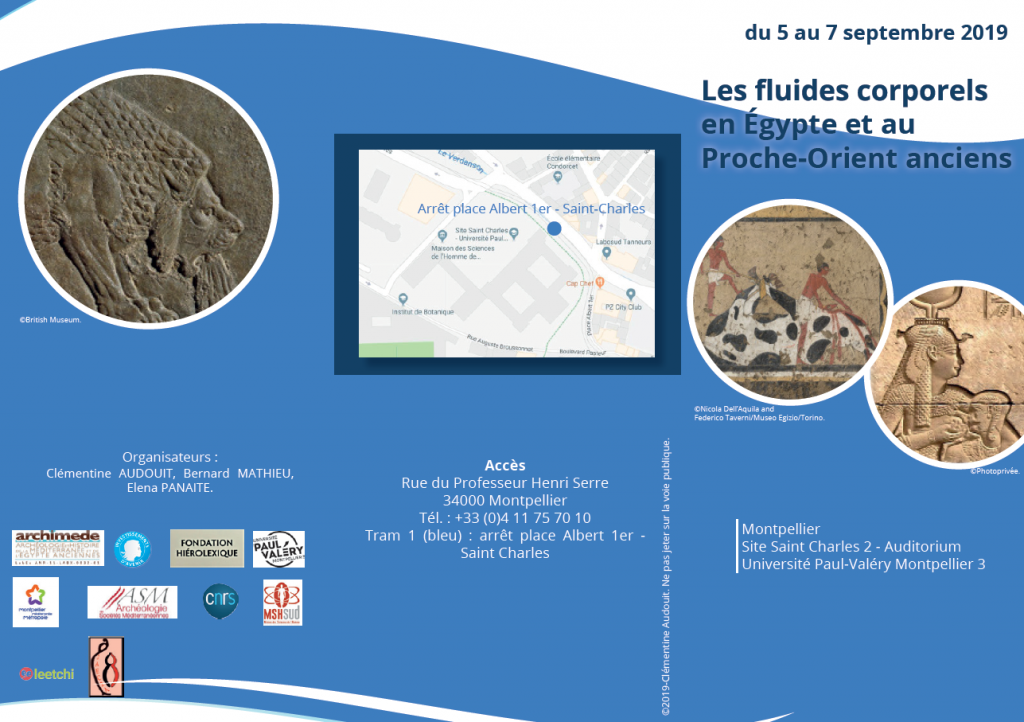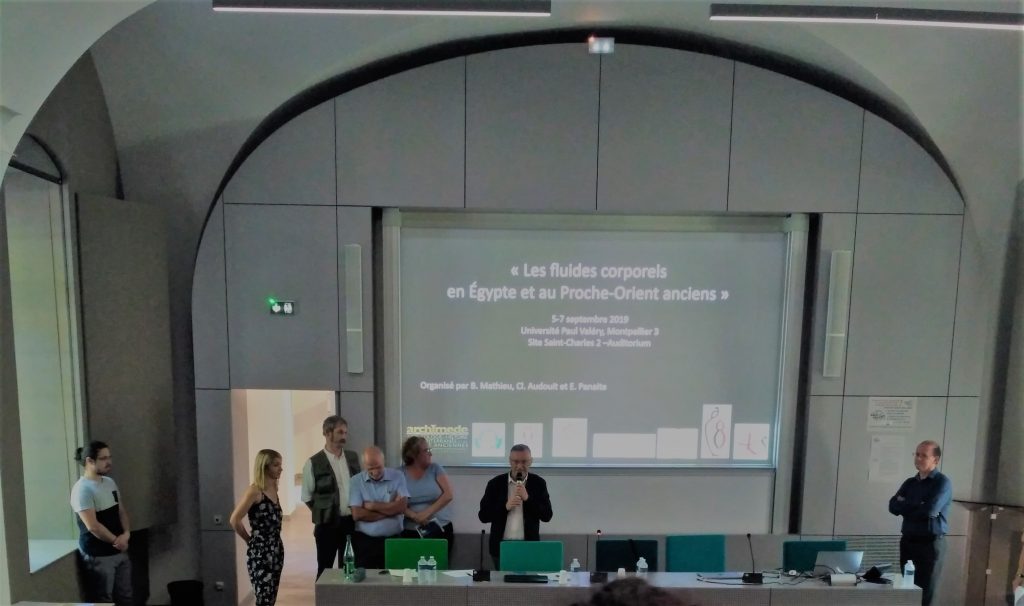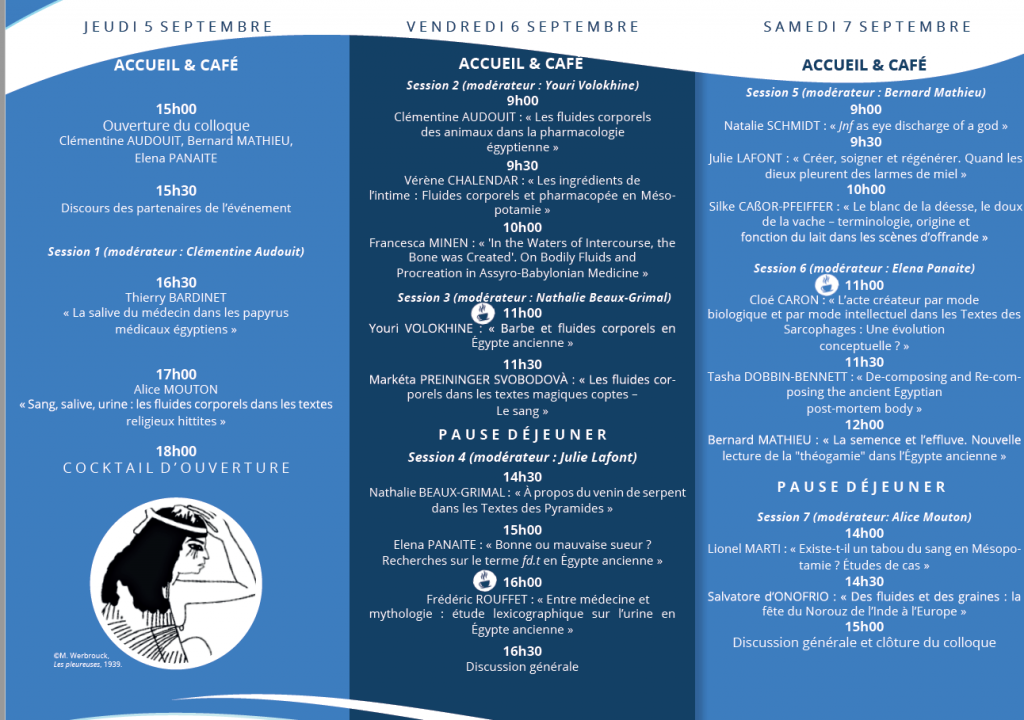
Last week, we had the chance to participate at what some of the attendees called a “revolutionary” conference on bodily fluids in sunny Montpellier. Marginal topics, especially touching upon the anthropology of the body, have not been the focus of events and publications up until the very recent years. The attendance was high, with many academics coming from France, Germany, Italy, or the United States. The topic of the body and its fluids is certainly gaining in popularity in the last few years, with many monographs, PhD theses and articles written on this issue. Therefore, it did make sense for the researchers to come together to discuss the matter. As a PhD thesis will be written in the frame of our research project by Markéta Preininger Svobodová on the body and its fluids in Coptic magical texts, we were glad to participate.
Various bodily fluids were discussed, in religious, medical and every-day life contexts. Clémentine Audouit (Universté Paul Valéry, Montpellier) presented a paper on (animal and human) bodily fluids in general in Egyptian texts. Her findings were surprising; for example, animal grease constitutes 50% of bodily substances mentioned in texts, after that milk, faeces and blood. Fluids in general were discussed also by Cloé Caron (Universté Paul Valéry, Montpellier; Université du Québec, Montréal), who looked at them from the perspective of corporeal creation (when deities engage in creative activity thought their sperm or tears, as opposed to intellectual creation). However, the bodily fluids were not only studied from the Egyptian context, but also in Mesopotamia and the Hittite world. Vérène Chalendar (Friedrich-Alexander-Universität, Erlangen-Nürnberg) presented various fluids of the body used in therapeutic practices and Alice Mouton (CNRS, Paris) initiated us into the use of urine, saliva or blood; she pointed out that saliva (and spitting in general), was very widely used in Hittite ritual, much more than blood. Lastly, bodily liquids in the Assyro-Babylonian tradition in their creative aspects were studied by Francesca Minen (Universita Ca’ Foscari, Venice), in medical and non-medical sources. Salvatore D’Onofrio (EHESS, Paris) closed the conference with his cross-cultural anthropological study of celebrations (although very much focused on Persian traditions), during which women grow seeds, and the ritual is sometimes accompanied by shedding of human or animal blood.

Blood was a topic of particular attention; two presentations were dedicated to it. Lionel Martin (CNRS, Paris) dedicated his twenty minutes to talk about the taboo on blood in Mesopotamian ritual, and he presented several case studies to support his theory. Markéta from our team presented preliminary results of her study of blood in Coptic magical texts; interestingly, in most cases where blood appears, this liquid has a mythological connotation – either with Christ, Osiris, or various Old Testament figures and events.
Tears and eye discharges were studied by two researchers, Natalie Schmidt (Eberhard Karls Universität, Tübingen) and Julie Lafont (Université Paul Valéry, Montpellier). Natalie Schmidt has convincingly shown that the Egyptian term jnf should be understood as discharge from the eye (rather than “tears”) and presented various examples where this term appears in divine context. Julie Lafont was interested in the similar functions of tears and honey, as they appear in religious and medical texts.
Six other fluids were examined during the conference: saliva, venom, milk, semen, sweat and urine. Thierry Bardinet (EPHE, Paris) examined the magical power of the saliva that the doctor applies on his finger (or spits) on the body part of the patient which is affected by disease. Saliva, according to Bardinet, transfers the magical power of the speech. Snake venom in Pyramid Texts was studied by Nathalie Beaux (College de France, Paris), and she focused particularly on the association between sperm and venom (the same term was often used for both). Semen in particular and its relationship with theogamy was the focus of the presentation of Bernard Mathieu (Universté Paul Valéry, Montpellier), who was also one of the organisers. Silke Cassor-Pfeiffer (Eberhard Karls Universität, Tübingen) examined milk, especially in the religious context and transmission of the divine, like in the temple scenes of goddesses nursing kings. Elena Panaite (Universté Paul Valéry, Montpellier) studied sweat, fd.t, in its capacity of regeneration but also in its negative connotations. Urine with its healing properties in medical texts and mythology was the last fluid discussed, by Frédéric Rouffet (Universté Paul Valéry, Montpellier).

Youri Volokhine (Université de Genève) asked the question if beards have a liquid quality to them – you can read what he has to say about it in the book “Barbe et barbus”.
Various stages of bodily decomposition and putrefaction fluids associated with them, and their connection with a pre-creative state, which is liquid in nature, were presented by Tasha Dobbin-Bennett (Emory University).
Many thanks to the organisers, particularly to Clémentine and Elena, for coordinating such an interesting conference. The proceedings from this conference will be published in the near future.
